BRAZIL IN 4 REGIONS
RIO & its surroundings – Salvador de Bahia & Northeast – Amazonia – Iguazu falls & Pantanal


Rio de Janeiro
The historical neighborhood of Rio also called “Centro” is easy to access by direct metro/subway from the South Zone where best hotels are located. The most emblematic Historical Center spots of Rio here below indicated:
- La Praça 15 – facing the Guanabara Bay, this square gathers colonial buildings such as: the Imperial Palace, now a cultural center of interest (free entrance), the Rio old cathedral built during the 18th century. Leaving from Place XV, strolling through small streets surrounded by 19th century buildings that keep the historical Rio’s memory intact. To see: the old Customs and Sao Bento Monastery, colonial pearls of Latin America (17th century).
- La Cinelândia – great central square where the Art Nouveau Opera (Council Theatre), the National Library and the fine arts museum stand, these last two were built early 19th century.
- La Lapa and the business center – Always lively, these neighborhoods consist of contemporary and old buildings. Lapa is the old bohemian area from 1930s which is again in vogue thanks to the old buildings’ restoration as well as typical bars and restaurants patronized by the local residents so-called “cariocas”. Cabarets such as “Carioca da gema” and “Rio Scenarium” play great Brazilian music to listen and to dance. From Thursday to Saturday night, you better book your ticket as it is a hot spot for “cariocas” of all ages…
Around Lapa, important religious monuments must be visited: Santo Antonio Convent, Sao Francisco of Penitência Church and the gigantesque Rio Cathedral, opened in 1976 and that can hold more than 3000 people.




La Praça Maua and the port area – neighborhood being renovated and blending historical and modern buildings. The view bay is magnificent and at the square two museums were just inaugurated the MAR (city museum) and the Amanha Museum (the museum of the future).
Symbolic places :
THE CORCOVADO – where the greatest statue in the world of the Redeemer Christ overlooks the city – 33 meters high – is easy to access by funicular leaving from Cosme Velho neighborhood.
In the heart of the Tijuca forest of Rio, wildlife and flora preserved, the very top of the Corcovado displays an exceptional 360° view of Rio between ocean and hills.
Between the Tijuca forest and the historical neighborhood, the Santa Tereza old neighborhood can be sightseeing with its traditional rich family’s mansions.
The pretty museum Fundaçao Castro Maia exhibits Jean Baptiste Debret watercolors, precious evidence of the colonial Rio.
SUGARLOAF MOUNTAIN – before ascending to the top of this huge rock by cog-railway, a walk around is worth going. Known as “pista Claudio Coutinho”, a 2 kilometers pathway opens up into a thick greenery and follows the ocean. Many birds and monkeys live there. This path is open to the public and was the former training location of the Brazilian football team…
From the Sugarloaf top, scenery view of the Guanabara Bay, the historical center and Copacabana beach. Best time to visit this site should be mid afternoon and stay until the twilight. Two additional advices to discover Guanabara Bay which has been classified World Heritage site by UNESCO: cruise on the bay and visit Niteroi, the city in front of Rio, for which Niemeyer has created a splendid contemporary art museum.
The view of Rio from the Museum is magnificent!


Between the mountains, the Rodrigo de Freitas lagoon and the Atlantic Ocean, a piece of land holds the posh neighborhoods of Rio: Copacabana, the cosmopolitan, and the elegant Ipanema and Leblon, where hotels, restaurants and bars stand alongside residential homes.
Please note that the avenues facing the beaches are pedestrian zones on Sundays. It is another meeting point for the locals for a walk or a ride.
Main streets for shopping are rue Nossa Senhora in Copacabana, for less costly souvenirs and for jewels and Brazilian designers, rua Visconde de Piraia, Ipanema. Every Sunday, in this neighborhood, a handicraft market called the “mercado hippie” is held at General Osorio square. The best “churrascarias” in town can be found in Copacabana. These restaurants are loved by the cariocas and not only by them….. As a great diversity of meat is served as much as you want.
Leblon is where the best beach of the city is located and also Dias Ferreira Street where small restaurants and bars attract the young golden crowd of Rio especially from Thursday to Sunday….
AROUND RIO
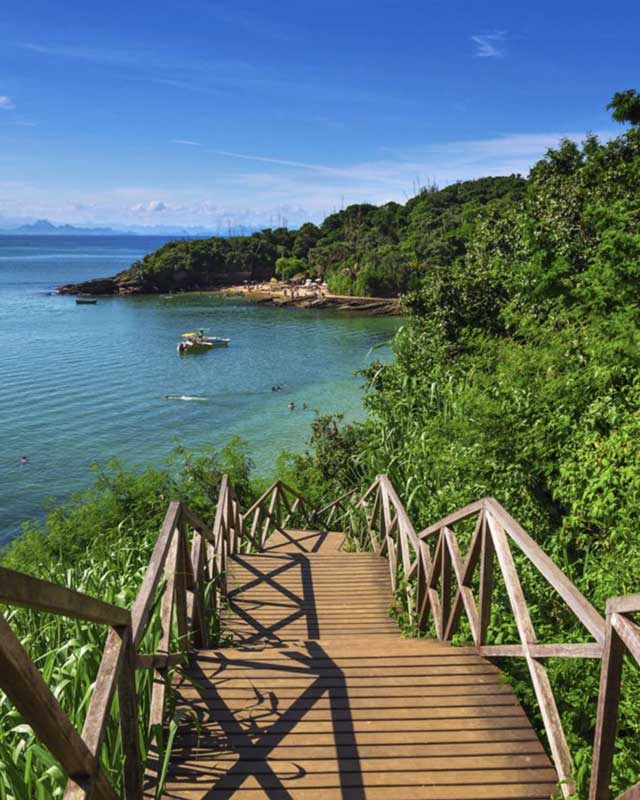
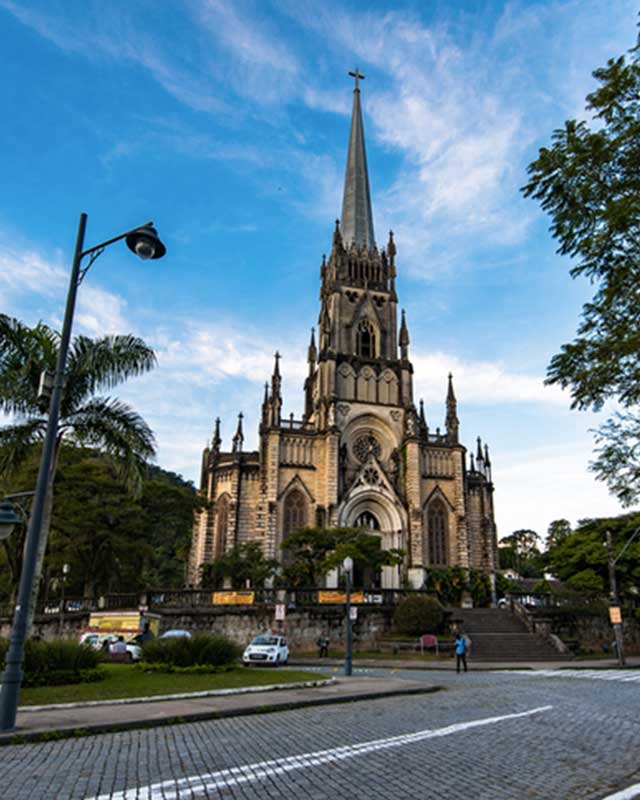
Pétropolis
One hour and half by bus or car away from Rio, it is the 19th century old holiday resort of the Brazilian imperial family. Mountains and greenery landscapes of great beauty as well as the city historical center should motivate the ones that greatly appreciate end of century neoclassic architecture.
Including to visit the Palace and Homes of Santos Dumont and Stefan Zweig.
BUZIOS
Through north Rio, the old fishing village became famous in the 60s, thanks to the well-known French actress Brigitte Bardot. Many gold sand beaches and the hectic activities of restaurants and bars make this beach resort an enjoyable and festive place to appreciate some restful days by the sea.
THE GREEN COAST
Towards the South of Rio and by a very scenic mountain road, follows Andra dos Reis Bay, interspersed by islands. The best season is undoubtedly the dry season, from May to September.
First stop at Andra dos Reis where main street, rua do Comérçio, displays churches and buildings dating from the colonial and imperial periods. But, Angra is mostly a posh beach resort and numerous high quality hotels and resorts have settled in the coastline.
Leaving from Angra, catamarans reach Ilha Grande in 45 minutes, it is the greatest island of the bay and famous for the still preserved beautiful wild beaches with the splendors of Nature. A privileged site for walks, hiking and for easy or more demanding treks. Nice rides on boat are also options to be considered, leaving from Abraao, Ilha Grande small village.
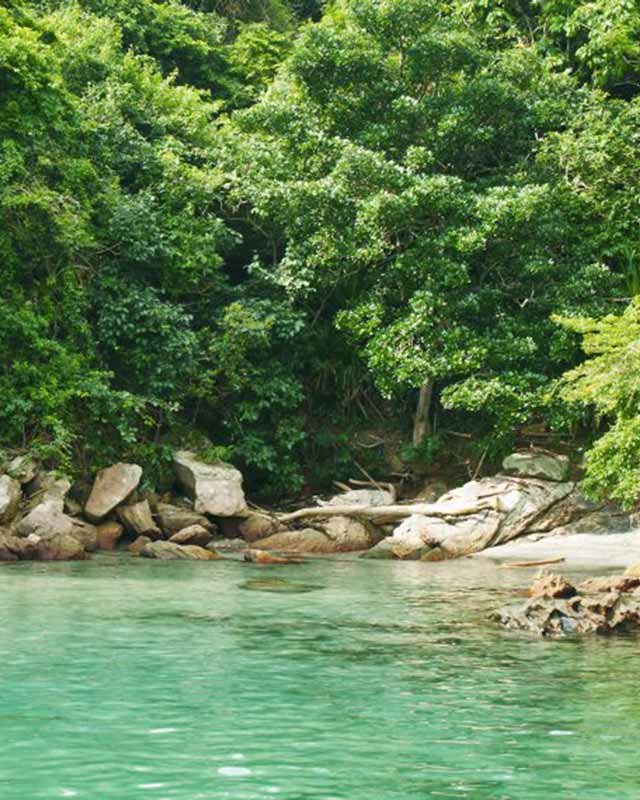
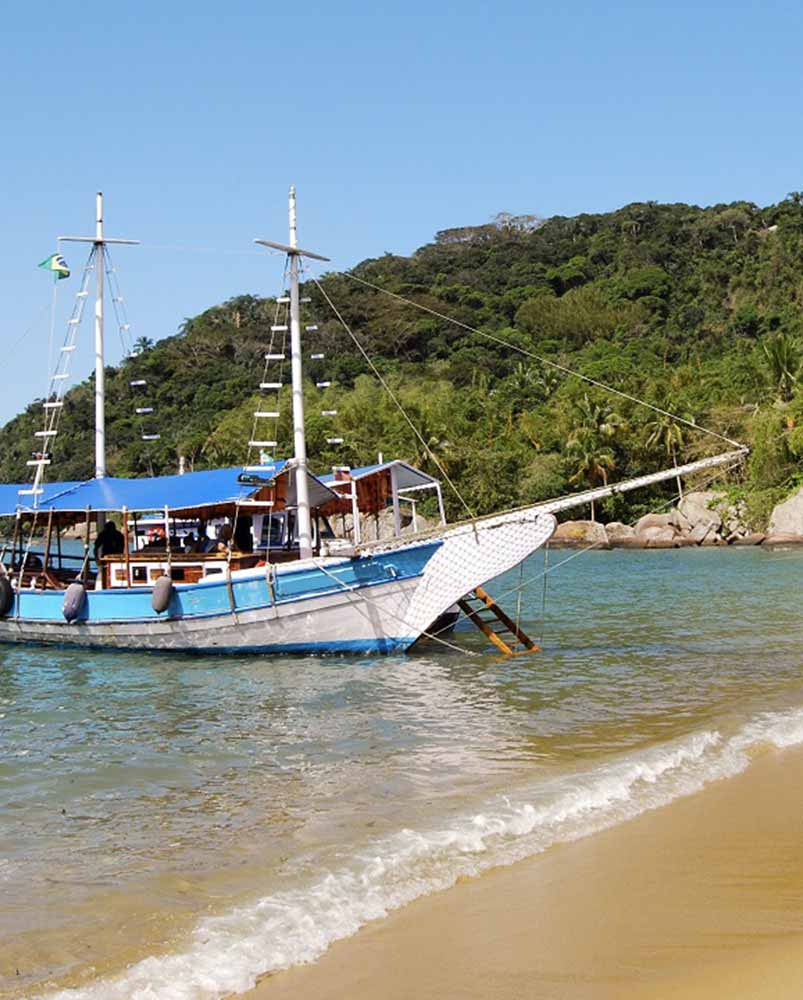
PARATI
One hour away from Angra, Parati delights by its privileged location between mountains covered by “mata-atlântica” and a quiet sea, easy to cruising back and forth (daily departures) or by small fishing boats.
The village is outstanding and has kept the urban structure of the imperial and colonial periods. Parati was an important harbor until mid-19th century when the village lost attractiveness sinking into oblivion.
The economic decline saved it and today Parati remains a nice example of former architecture: small houses with wrought iron balconies; four baroque rococo style churches. Santa Rita church, opened in 1722, shelters a small museum of sacred art that tells the village mystic enthusiasm. Many religious holidays are part of the events calendar of Parati including “Divino” – Pentecost/Whit Sunday.

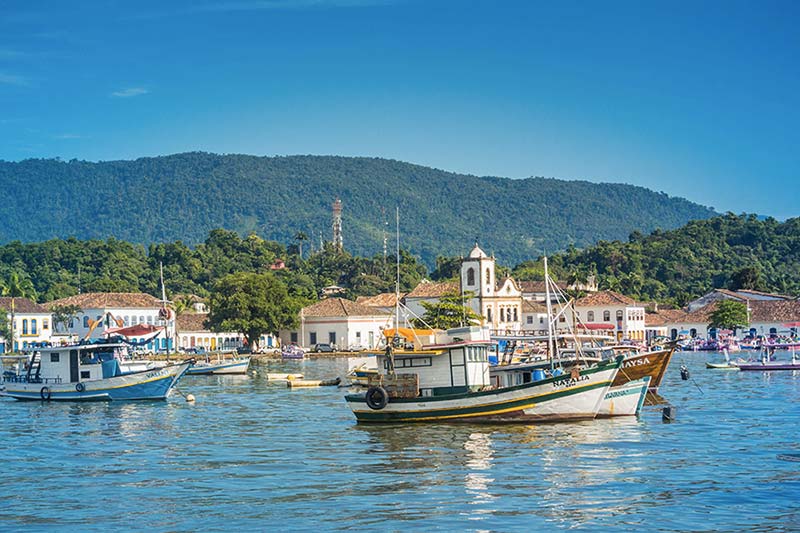
THE HISTORICAL CITIES OF MINAS GERAIS
For history and art lovers, for everyone passionate about old towns, the cities of Minas Gerais, all belonging to the “Estrada real” for gold, the itinerary of the mines operated during colonial Brazil, is a dream destination. To the cultural delight can be added the gastronomic pleasure as Minas is recognized for its rich and delicious cuisine.
The departure point to access the cities of Minas is the Belo Horizonte’s airport, about 2 hours away by plane from Rio or Salvador de Bahia. An itinerary through the historical cities can be done by car. The distance between the cities is about 3 hours.
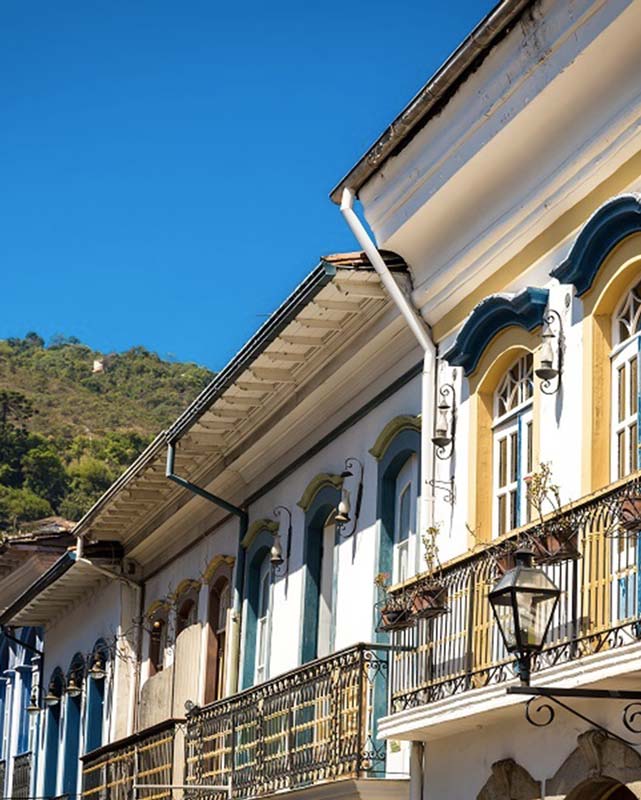
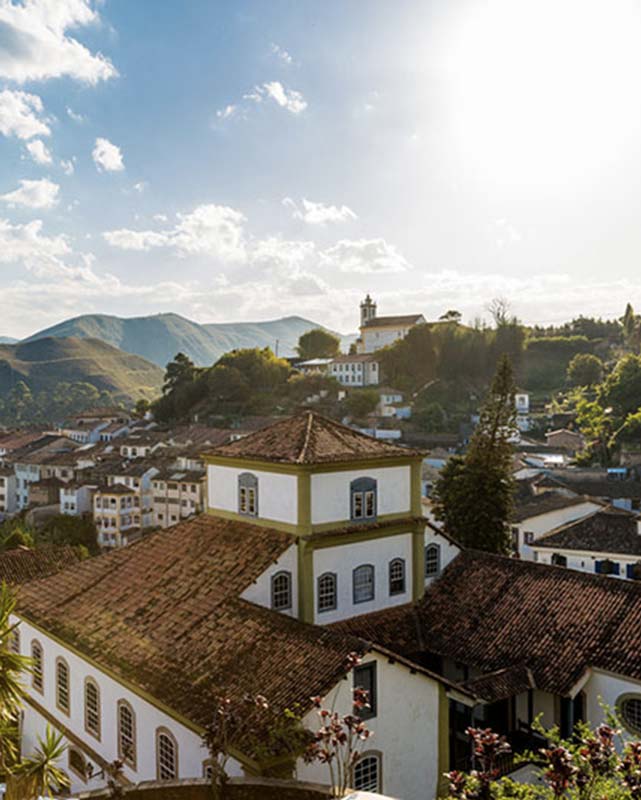
OURO PRETO : city designated a Unesco World Heritage Site. Two full days minimum to fully discover the traditional Vila Rica, capital of gold in Brazil during the 18thcentury. The cobble stone streets ascending to the square Tiradentes, heartbeat of the city, are framed by dwellings and churches decorated with splendor. Ouro Preto is a living proof of the baroque style in Brazil, the most important artist is without a doubt Aleijadinho, architect and sculptor.
Must visit the church of Sao Francisco de Assis, the church of Nossa Senhora do Pilar (our Lady of the Pillar) and the church of Santa Efigência dos Pretos, this last one built by and for the African slaves, numerous in the region to work in the gold mines.
The museum of Inconfidência towers over the square Tiradentes and is set up inside the old city hall and prison of the city. This museum houses the main work of Aleijadinho and Ataide (great painter from the colonial period) and also displays memories from the revolt for independence carried out by Tiradentes and strongly crushed by the Portuguese crown.
Important: Museums and churches are closed on Mondays
Congonhas do Campo, at one hour by the road from Ouro Preto and one hour and half from Belo Horizonte, this is stop not to be missed to capture the Brazilian baroque religious style.
On the very top of a hill, the basilica of Bom Jésus de Matosinhos embellished by the esplanade of the prophets, masterpiece by Aleijadinho, is designated a UNESCO World Heritage site.
In front of the basilica, chapels containing the main scenes of the passion of Christ through sculptures in natural size are part of the artistic heritage left by Aleijadinho.
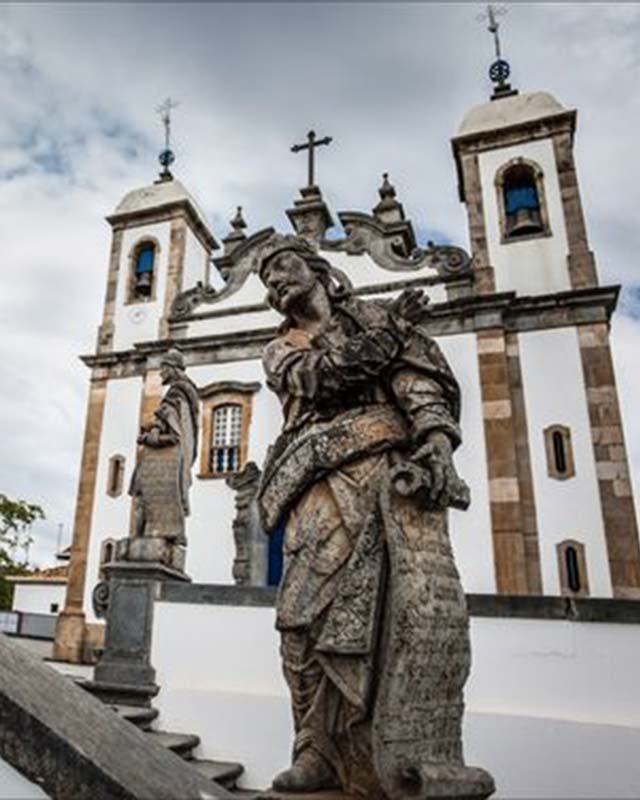
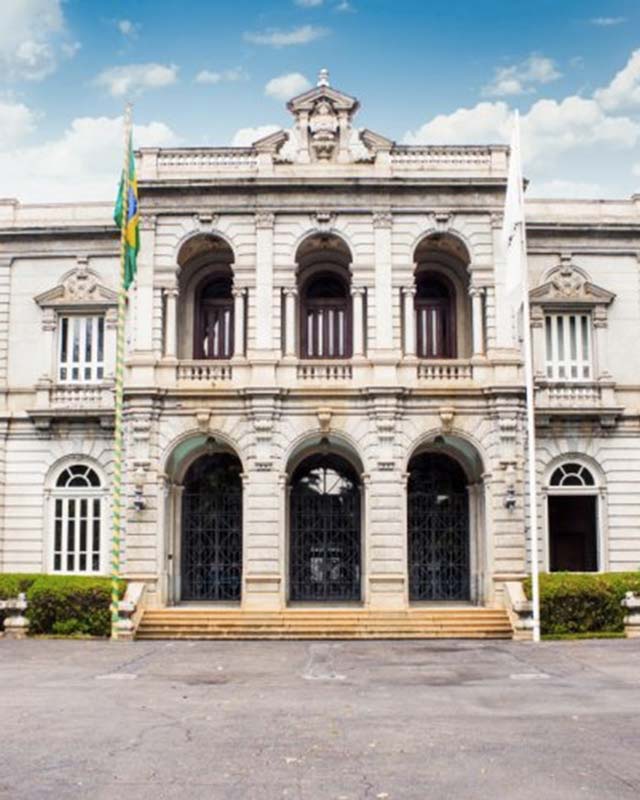
Tiradentes, two hours from Ouro Preto, persists to be a delightful small town from the 18thcentury whose urban plan and architectural heritage have been perfectly preserved. Many fountains from the colonial period intersperse places and street corners adding a distinctive charm to the city. The touristic development of Tiradentes has created numerous boutiques of antics and regional craft of high quality. Go bargain-hunt especially for wood statues of the “lions de Tiradentes”.Must-see places:
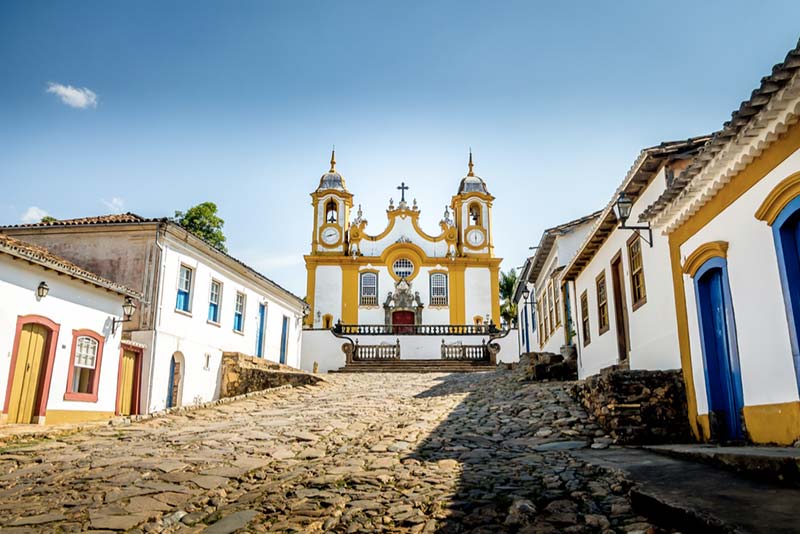

A ne pas manquer :
- San Antonio Church ,18thcentury, overlooks the city and is the last masterpiece of Aleijadinho. Magnificent interior with very rich decorations in gold, in a unique baroque rococo style.
- Padre Toledo Museum,recently restored, is located in the old house of Father Toledo, one of the participants of the revolt against the Portuguese in 1792. There are 18 rooms telling the art of living in Minas during the colonial period.
- Walk in the Serra de Sao José through trails opened in the Atlantic tropical vegetation.
- Travel aboard the steam train between Tiradentes and Sao Joao Del Rey. About 30 minutes.

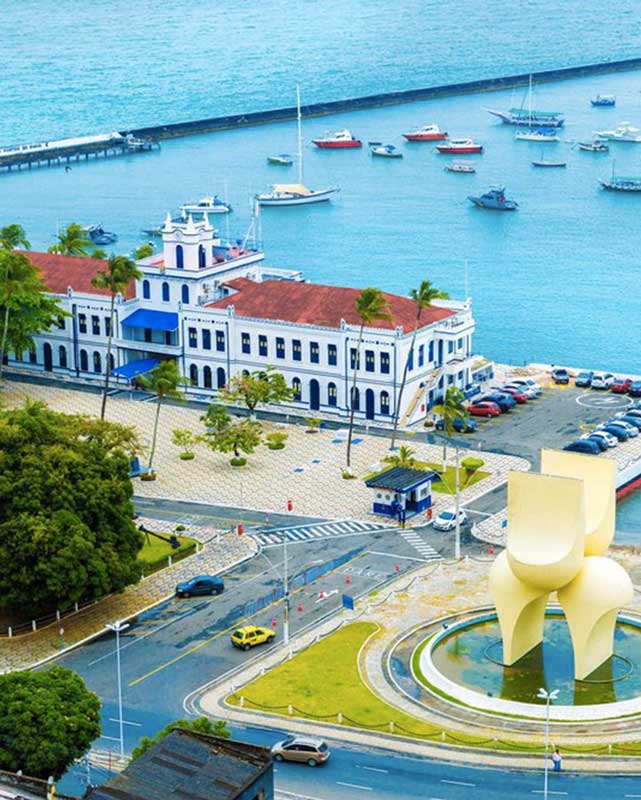
Salvador de Bahia
Two hours flight from Rio and Sao Paulo is reachable from Europe by TAP Portugal via Lisbon. This is an excellent starting point for a trip to Brazil and more specifically to the Northeast.
First capital of Brazil from 1549 to 1763, Salvador de Bahia has been a merging point for European, African, and Amerindian cultures. The city also was, since 1558, the first market of slaves heading to the sugar cane plantations in the New World. The city was able to protect many exceptional examples of Renaissance architecture. The polychrome houses with lively colors, often decorated in high quality stucco, are one of the characteristics of the old city whose downtown was designated a UNESCO World Heritage Site.
SALVADOR – the “Cidade Alta” – The high city – with its historical downtown called the “Pelourinho”, a maze of winding streets surrounded by dwellings, churches and convents built during the colonial and imperial periods. This is the ultimate “tropical baroque” and the population of Salvador, very mixed, keeps the popular afro-Brazilian traditions, the most authentic in Brazil.
This is a festive city and its calendar of events is rich all year long. Nevertheless, the big popular festivities mixing catholic rites and African deriving from the animist religion, the candomblé, take place from December 4th until the last day the Carnival (February/March).
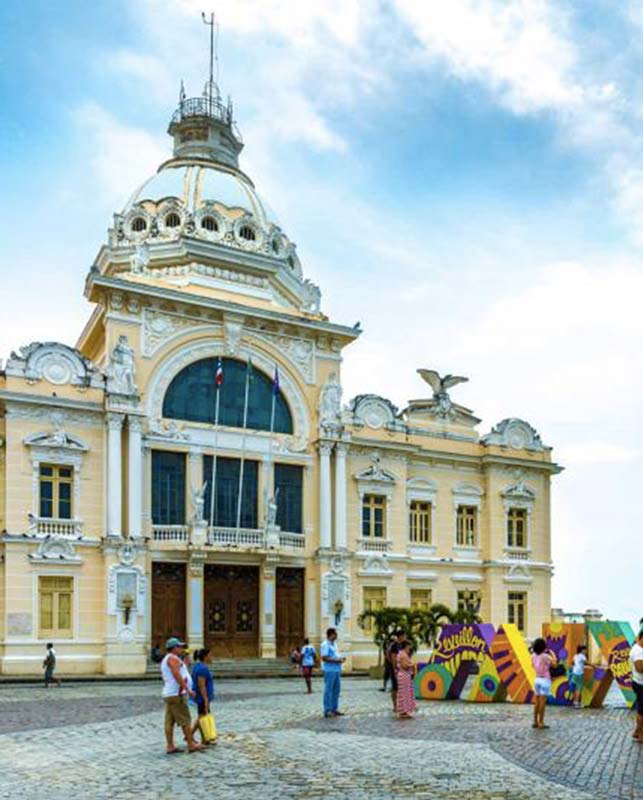
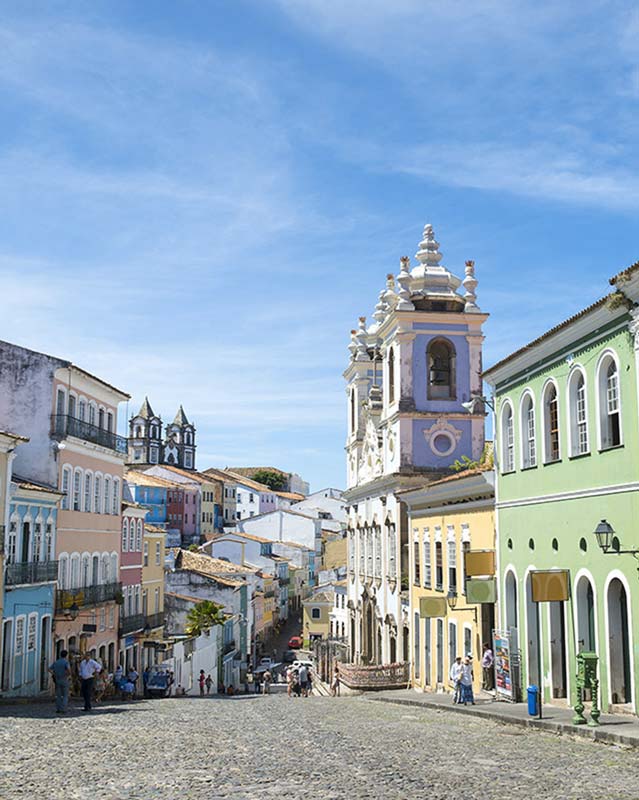
A ne pas manquer dans le Pelourinho
The square “Terreiro de Jesus” where a lively crowd is present all day and late in the evening. Sao Francisco Church and its cloister are testament of the wealth of Salvador during the colonial period. The ornamentation inside the building presents one of the most splendid examples of the Brazilian baroque style, certainly busy but still magnificent.
Time should be devoted to discover the churches of Salvador because they are many and most of them are worth visiting. In the neighborhood of Pelourinho, we can quote the Sé (the cathedral), the church of Our Lady of the Rosary for Blacks (on Tuesday night, an Afro-Catholic service gathers the Black community of the city) and the frontage of the church Ordem Terceira de Sao Francisco.
While wandering in the Pelourinho, it is possible to visit the emblematic associations of capoeira (Afro-Brazilian martial art) and Carnival associations (Olodum, Filhos de Gandhi).
Outside of the Pelourinho, the neighborhoods of Vitoria and Barra, facing the bay of All the Saints with places of interest not to be missed: the museum Costa Pinto housing a beautiful collection of jewels that belonged to the slaves of wealthy homes; the lighthouse and the delightful tropical ambience of the avenue by the sea.
SALVADOR, the “Cidade Baixa” – the cornerstone city linked to the high city by the elevator Lacerda built in the 30s and that can transport up to 100 people each ride.
This is the port town area of Salvador, in front of the bay of All the Saints where boats are departing for cruises to the island of Itaparica. Opposite the harbor, it is possible to visit the largest craft market of the city, “Mercado Modelo”. Huge amount of boutiques, restaurants and bars.
Must-see places in the “Cidade Baixa”:
- The popular Sao Joaquim Market: fruits, vegetables and spices. Preferably visit early in the morning when the boats loaded of merchandise arrive to the little harbor.
- Nosso Senhor do Bonfim Church, high place of pilgrimage for Bahia and all Brazil. Glance at the room of the ex-voto.


LEAVING
Salvador de Bahia
Towards north, a series of pristine beaches with a ring of palm trees around them facing the Atlantic Ocean. Amaralina, Pituba and the famous Itapuan close to the lagoon of Abaeté. Further out, the ancient fishing village of Praia do Forte is today a very popular beach resort. This is a very lively ambiance, with plenty of bars and restaurants. At the center of the village, a small church and the TAMAR Park, project for the protection of marine animals, invite to discovery. Among the remote beaches, Mangue Seco remains to be a place that has still not be touched by tourism. An adorable village and beaches with endless dunes create the perfect setting.
Towards south, the region of Recôncavo Baiano, formerly important financial hub because of the tobacco plantations. Three hours away from downtown Salvador, the road becomes extremely beautiful after Santo Amaro de Purificaçao, lined with sugar cane plantations. But, Cachoeira and Sao Felix, on the banks of the Paraguaçu River, are the ones that still really preserve the memories of the period of tobacco (beginning 19th century). To be highlighted the popular market of Cachoeira every Saturday morning.
Bahia Coastline – The undeniable appeal of the pristine beaches in Brazil, is without a doubt due to the cities and quaint villages close by.
Thus Ilhéus and Itacaré in the cocoa region, Arraial da Ajuda and Troncoso hold the necessary ingredients to love for those who want to spend a few days relaxing on some tropical beaches while travelling.
RECIFE
RECIFE AND OLINDA – Leaving from Europe, Tap Portugal offers direct flights via Lisbon to Recife.
Built during the period of the Dutch invasion, Recife and Olinda, twenty minutes away from each other, are nevertheless very different historical cities.
Recife is a capital, built between two rivers by the Dutch in the 17thcentury, attempting to replicate a city like Amsterdam with canals and bridges. The history and richness of Recife are linked to sugar, the state of Pernambouc being still a great Brazilian sugar producer.
Must-see places:
- The “Capela Dourada”– Inside Sao Francisco Church, a jewel of the Brazilian baroque art.
- Kazal Zur Isreal synagogue, the first one created in Latin America, fully restored and open to visitors.


OLINDA
Olinda, located within the tropical vegetation, is a city that rather looks like a village with colorful houses and beautiful colonial churches. Its Carnival is one of the most extraordinary expressions of the rich folklore of Pernambouc with its parades “frevo”, acrobatic dance accompanied by popular orchestras. Leaving from Recife, at about 1 hour flight, the archipelago of Fernando de Noronha, national park a place to observe the coastal fauna and enjoy this privilege location for beaches still well preserved.
FORTALEZA , ITACOATIARA . Leaving from Europe, Tap Portugal proposes direct flights via Lisbon to Fortaleza.
About three hours away from Fortaleza, the village of Itacoatiara, fishing town and posh beach resort, remains a charming location to enjoy the pleasures of the beach between dunes and easy-going hustle and bustle.


THE Delta OF Parnaiba, Sao Luiz & Lencois Maranhenses
For the lovers of spectacular and out of the ordinary Nature. Leaving from Sao Luiz, historical city created during the French invasion of Brazil, 3 hours by a stunning tropical road are necessary to arrive to Barreirinhas, typical small town of the Northeast on the banks of the Preguiça River.
From this city, departure to the sighting of the Lençois maranhenses, true false desert of dunes, isolated between the river and the exuberant vegetation. In the middle of the dunes, clear water lagoons outline this desert formed by millions of years of sand buildup… Surprise, astonishment! No traveler can be unmoved by this phenomenon of Nature.
The Delta of Parnaiba, a few hours away from Lençois, is a national park rich in fauna and flora from the North. These two locations where Nature is so precious are highly recommended to be visited by 4X4 vehicles with expert guides.
MANAUS
Manaus can be accessed by domestic flights leaving from Rio and Sao Paulo (5 hours flight with stop) and from Europe with Tap Portugal via Lisbon.
Manaus offers the visitors many contrasts. Located in the core of the jungle, the city has preserved many monuments that are testament of its sumptuous past.
Emblematic relics of the ephemeral but glorious period of the rubber, the famous theatre Amazonas and the palace Rio Negro. The theatre or opera house has been re-opened to the public after several decades. It is a full house, two to three times a week, also during the occasion for a lyric art festival held every year and that attracts the biggest names in the world of opera.

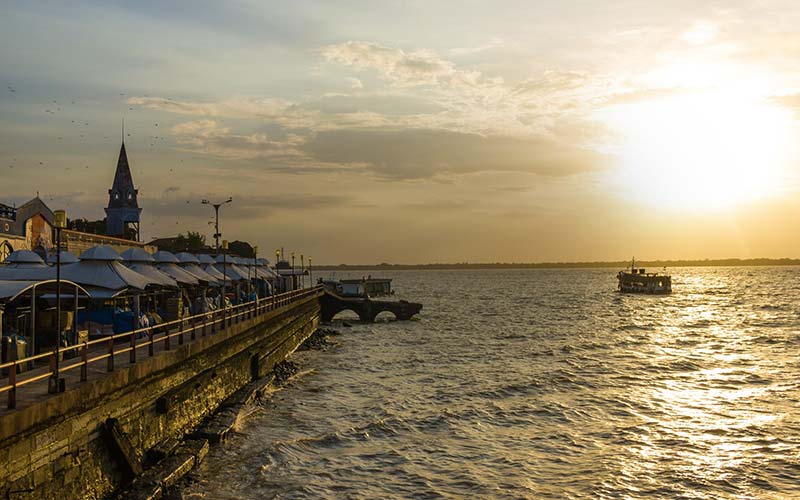
Not too far, adjoin to the floating harbor, the municipal market has literally overflown from the limits of the Eiffel style shed built to welcome it at the beginning of the 20th century. This is a meeting point for the city-dwellers and the people living in the rainforest, and who go to Manaus to sell the products from nature (manioc, fish, handicrafts … ) and also to buy products.
Must-see:
- The formation of the Amazon River by Manaus, known as “the meeting of the waters” from the rivers Negro and Solimoes that do not mix together due to the power of their flow.
- The archipelago of Anavilhanas, north of Manaus, is the place where the rainforest is still very well preserved. The best way to discover this Nature’s sanctuary is, without a doubt, by 3 or 4 day cruises.
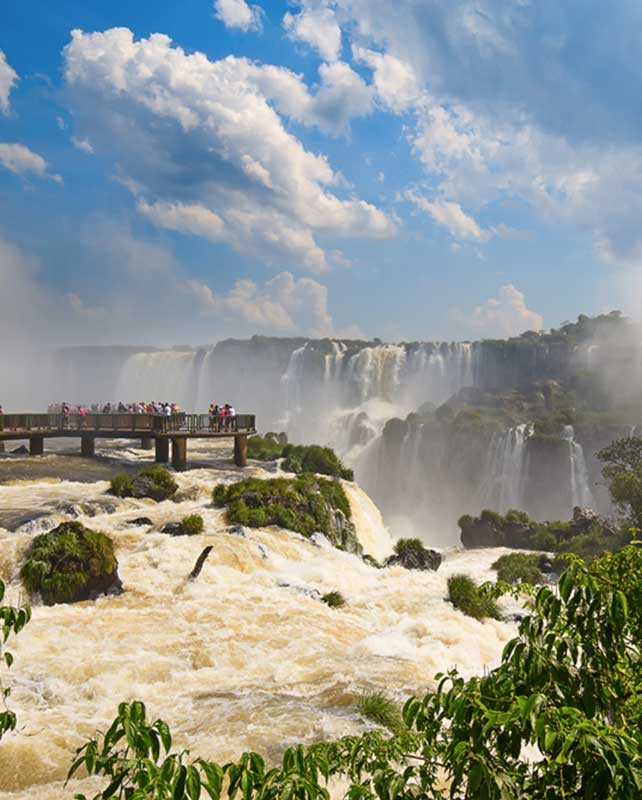

Les chutes d’Iguazu
Iguazu Falls – Two hour flight from Rio. Many daily flights. Other connections are possible leaving from Buenos Aires in Argentina.
In the heart of the lush subtropical forest, the largest in our planet, are located the spectacular waterfalls, more than 250, that can be accessed on foot by walkways. An encounter with the powerful Nature of South America. The national park of Iguazu is situated on the border between Argentina and Brazil. A bridge links two cities: Puerto Iguazu (Argentina) and Foz d’Iguaçu (Brazil).
Visit of the falls on the Argentinean side: A train regularly departs from the visitor center and stops at the main viewpoints. By trails, through the dense forest, you can reach a canyon where hundreds of falls cause an overwhelming roar. The main fall is the Devil’s Gorge- 100 meters tall – It is easy to approach taking a long walkway.
At the bottom of the waterfalls, a free speedboat helps you to get to the San Martin Island to admire the Salto de San Martin closer.
This is the second most powerful waterfall of the location after the Devil’s Gorge.
Visit of the Brazilian side: this promenade aims to the panoramic view of waterfalls, the canyon and the forest.
The viewpoint is spectacular! It is possible to fly over the waterfalls by helicopter and take walks in the forest with specialized guides.




THe Pantanal
THE PANTANAL is located in the Western-Central part of Brazil. Large national park particularly for the observation of animals. Two cities remain the best departure points, Cuiaba (North Pantanal) and Campo Grande (South Pantanal).
Best period to visit: from May to September.
Pantanal North – dominated by the Chapada dos Guimaraes, rocky formations in the heart of the savanna and the rivers. The interest focus in North Pantanal is precisely a 3 to 4 day stay including easy hikes to the Chapada, canoe rides to observe the fauna and excursions in 4X4 vehicle through the savanna.
Pantanal South – From Campo Grande, the road of the Pantanal provides access to lodges where stays lead by forest guides facilitate the observation of numerous birds often unknown by Europeans, for example the tuiuiu, symbol of the region


